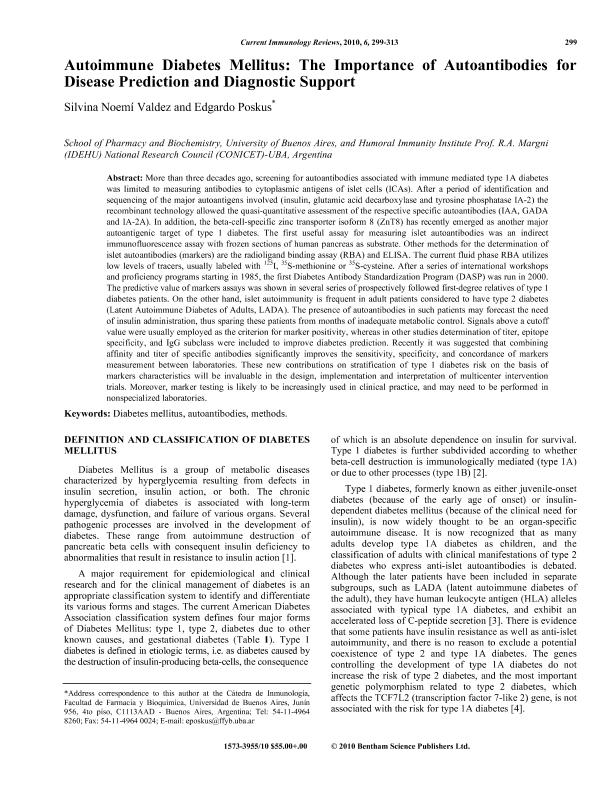Artículo
Autoimmune Diabetes Mellitus: The Importance of Autoantibodies for Disease Prediction and Diagnostic Support
Fecha de publicación:
11/2010
Editorial:
Bentham Science Publishers
Revista:
Current Immunology Reviews
ISSN:
1573-3955
Idioma:
Inglés
Tipo de recurso:
Artículo publicado
Clasificación temática:
Resumen
More than three decades ago, screening for autoantibodies associated with immune mediated type 1A diabetes was limited to measuring antibodies to cytoplasmic antigens of islet cells (ICAs). After a period of identification and sequencing of the major autoantigens involved (insulin, glutamic acid decarboxylase and tyrosine phosphatase IA-2) the recombinant technology allowed the quasi-quantitative assessment of the respective specific autoantibodies (IAA, GADA and IA-2A). In addition, the beta-cell-specific zinc transporter isoform 8 (ZnT8) has recently emerged as another major autoantigenic target of type 1 diabetes. The first useful assay for measuring islet autoantibodies was an indirect immunofluorescence assay with frozen sections of human pancreas as substrate. Other methods for the determination of islet autoantibodies (markers) are the radioligand binding assay (RBA) and ELISA. The current fluid phase RBA utilizes low levels of tracers, usually labeled with 125I, 35S-methionine or 35S-cysteine. After a series of international workshops and proficiency programs starting in 1985, the first Diabetes Antibody Standardization Program (DASP) was run in 2000. The predictive value of markers assays was shown in several series of prospectively followed first-degree relatives of type 1 diabetes patients. On the other hand, islet autoimmunity is frequent in adult patients considered to have type 2 diabetes (Latent Autoimmune Diabetes of Adults, LADA). The presence of autoantibodies in such patients may forecast the need of insulin administration, thus sparing these patients from months of inadequate metabolic control. Signals above a cutoff value were usually employed as the criterion for marker positivity, whereas in other studies determination of titer, epitope specificity, and IgG subclass were included to improve diabetes prediction. Recently it was suggested that combining affinity and titer of specific antibodies significantly improves the sensitivity, specificity, and concordance of markers measurement between laboratories. These new contributions on stratification of type 1 diabetes risk on the basis of markers characteristics will be invaluable in the design, implementation and interpretation of multicenter intervention trials. Moreover, marker testing is likely to be increasingly used in clinical practice, and may need to be performed in nonspecialized laboratories.
Palabras clave:
Diabetes Mellitus
,
Autoantibodies
,
Methods
Archivos asociados
Licencia
Identificadores
Colecciones
Articulos(IDEHU)
Articulos de INST.DE EST.DE LA INMUNIDAD HUMORAL PROF.R.A.MARGNI
Articulos de INST.DE EST.DE LA INMUNIDAD HUMORAL PROF.R.A.MARGNI
Citación
Valdez, Silvina Noemi; Poskus, Edgardo; Autoimmune Diabetes Mellitus: The Importance of Autoantibodies for Disease Prediction and Diagnostic Support; Bentham Science Publishers; Current Immunology Reviews; 6; 4; 11-2010; 299-313
Compartir
Altmétricas




